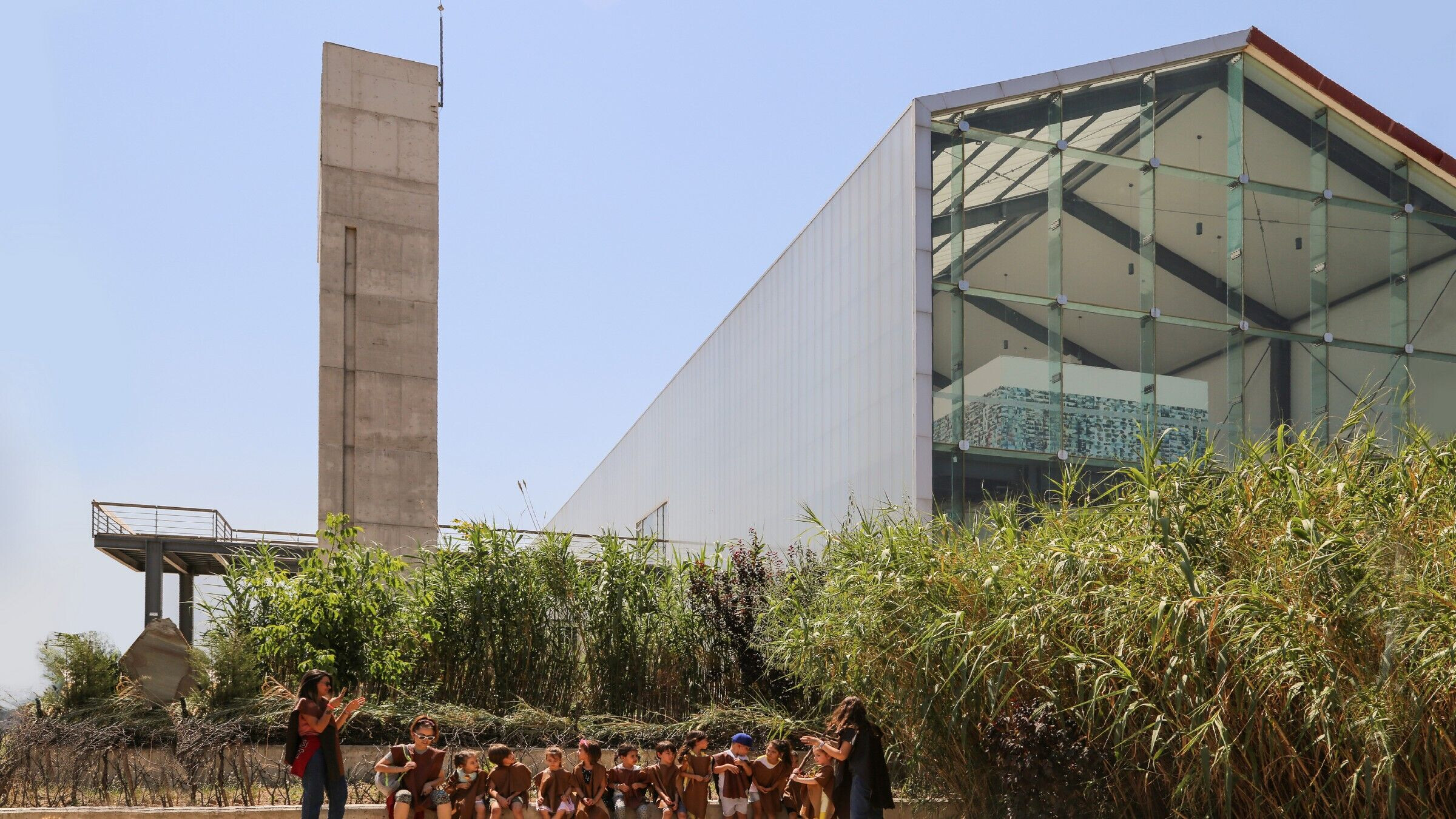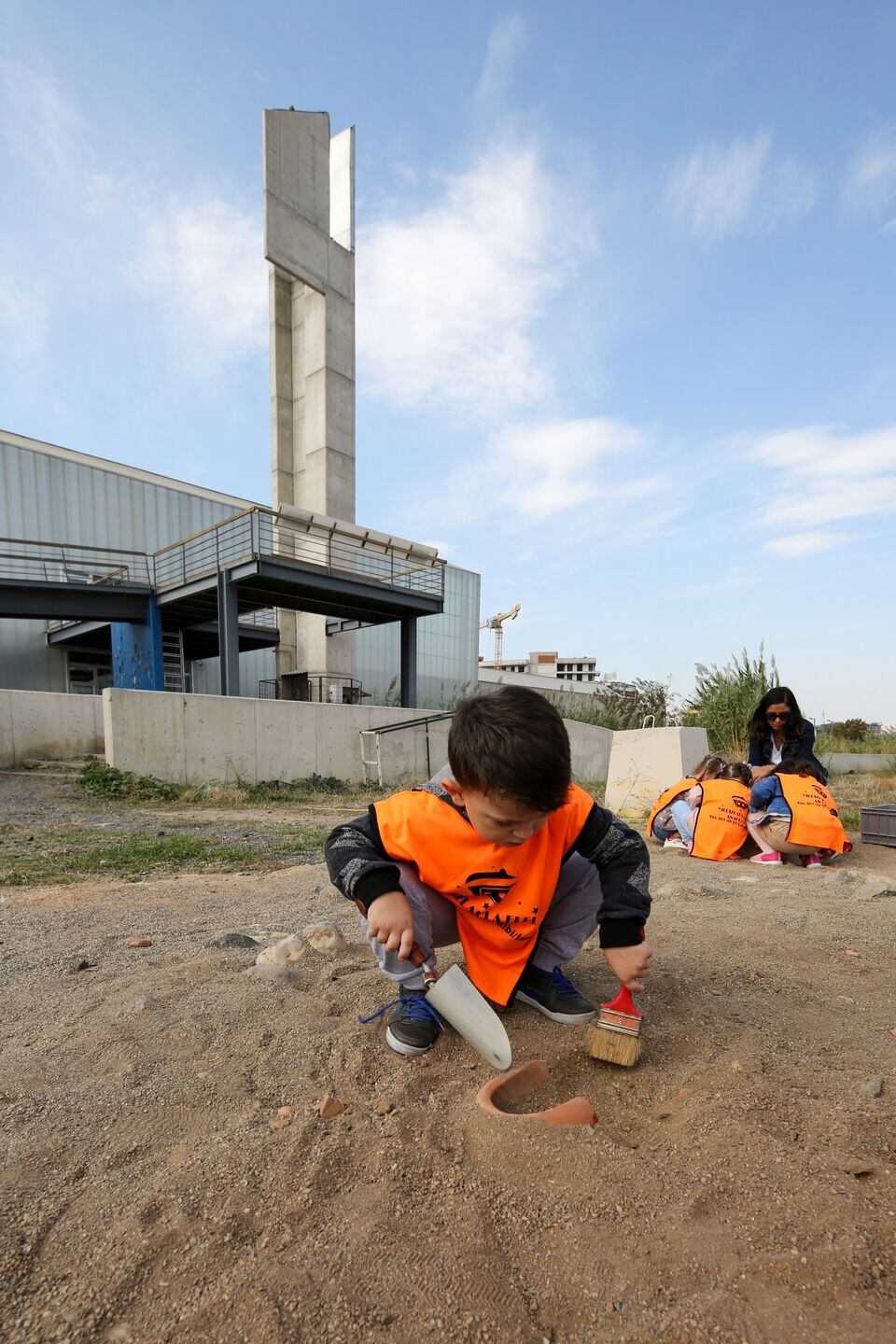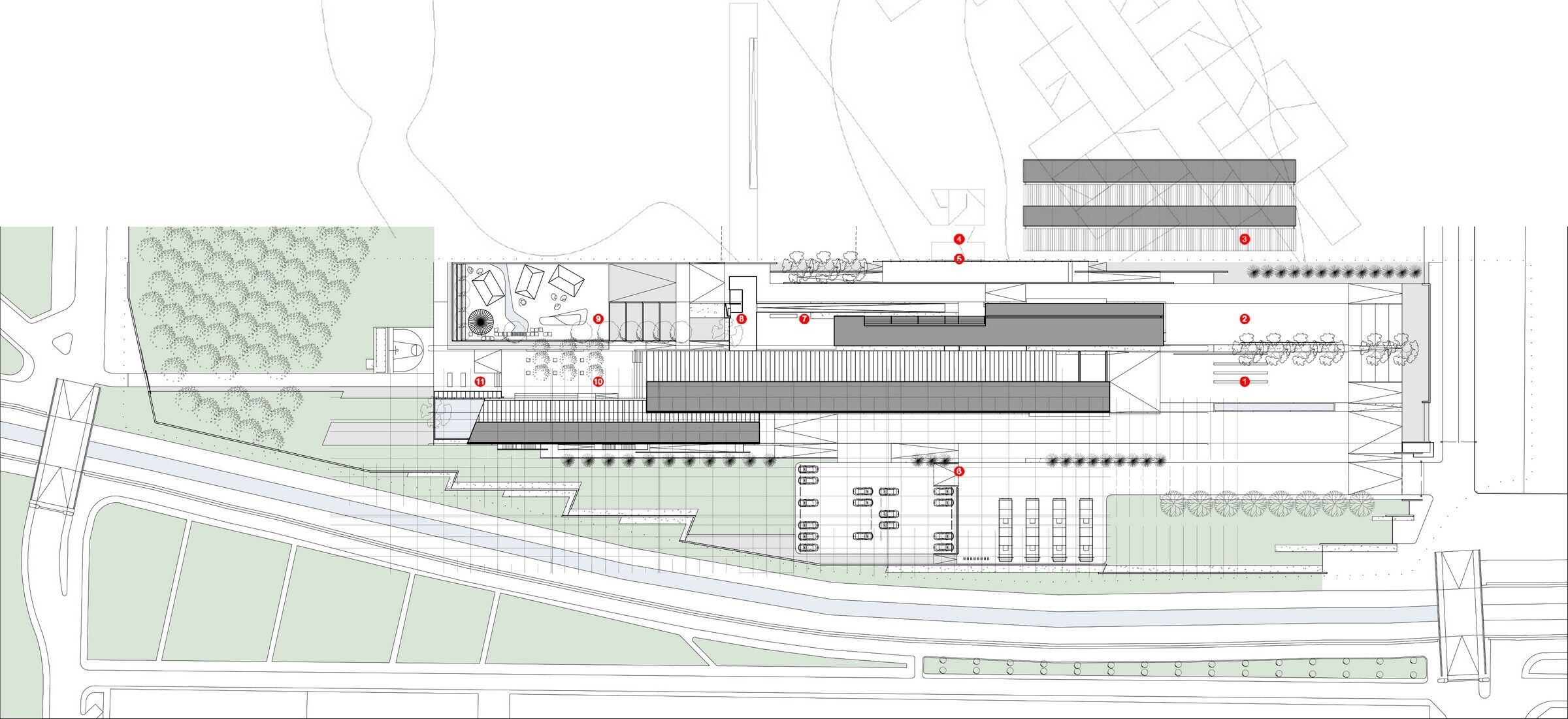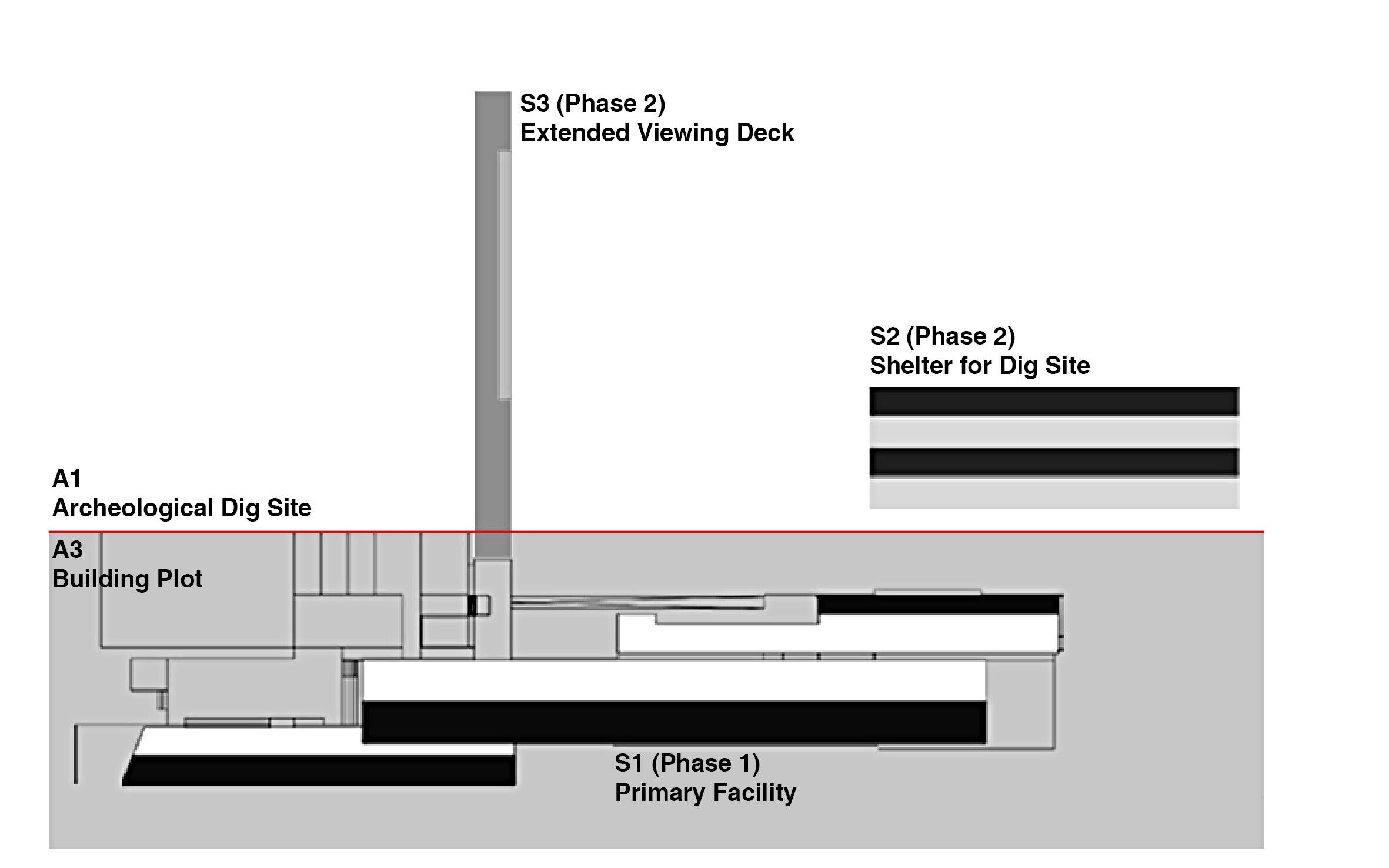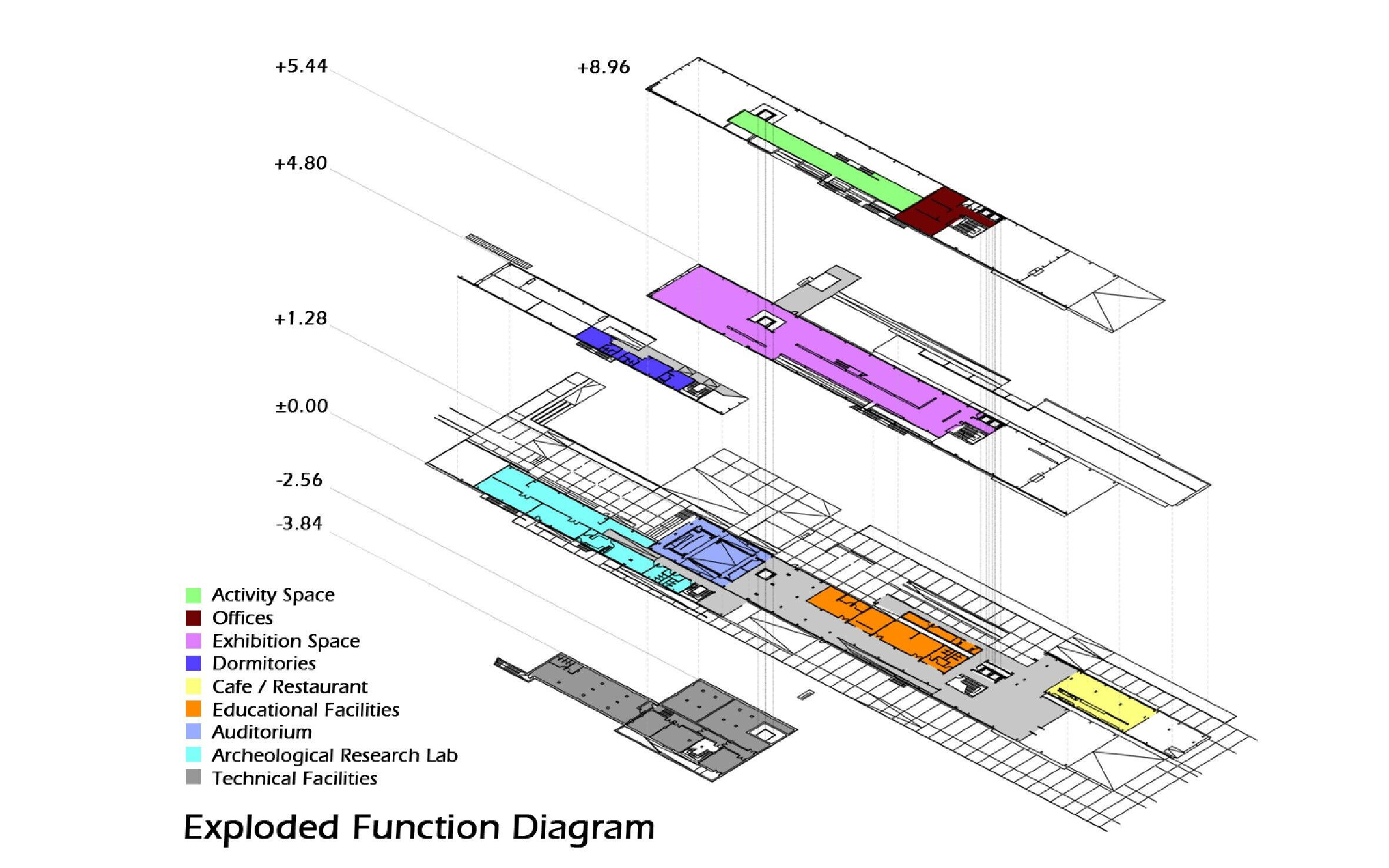In Between Ages…
Settled in the adjacent plot along the northwest - southeast border of the Yesilova Höyük archaeological excavation site, the building intends to create a spatial interface between 6.500 BCE and the present with its form, alignment, and materials. Chosen as the winning project in a national architectural competition in 2010 and built in 2014, the complex generates an unexpected cultural focus within the urban context through an intricate architectural program which is composed of artifact exhibition, active education, and scientific research.
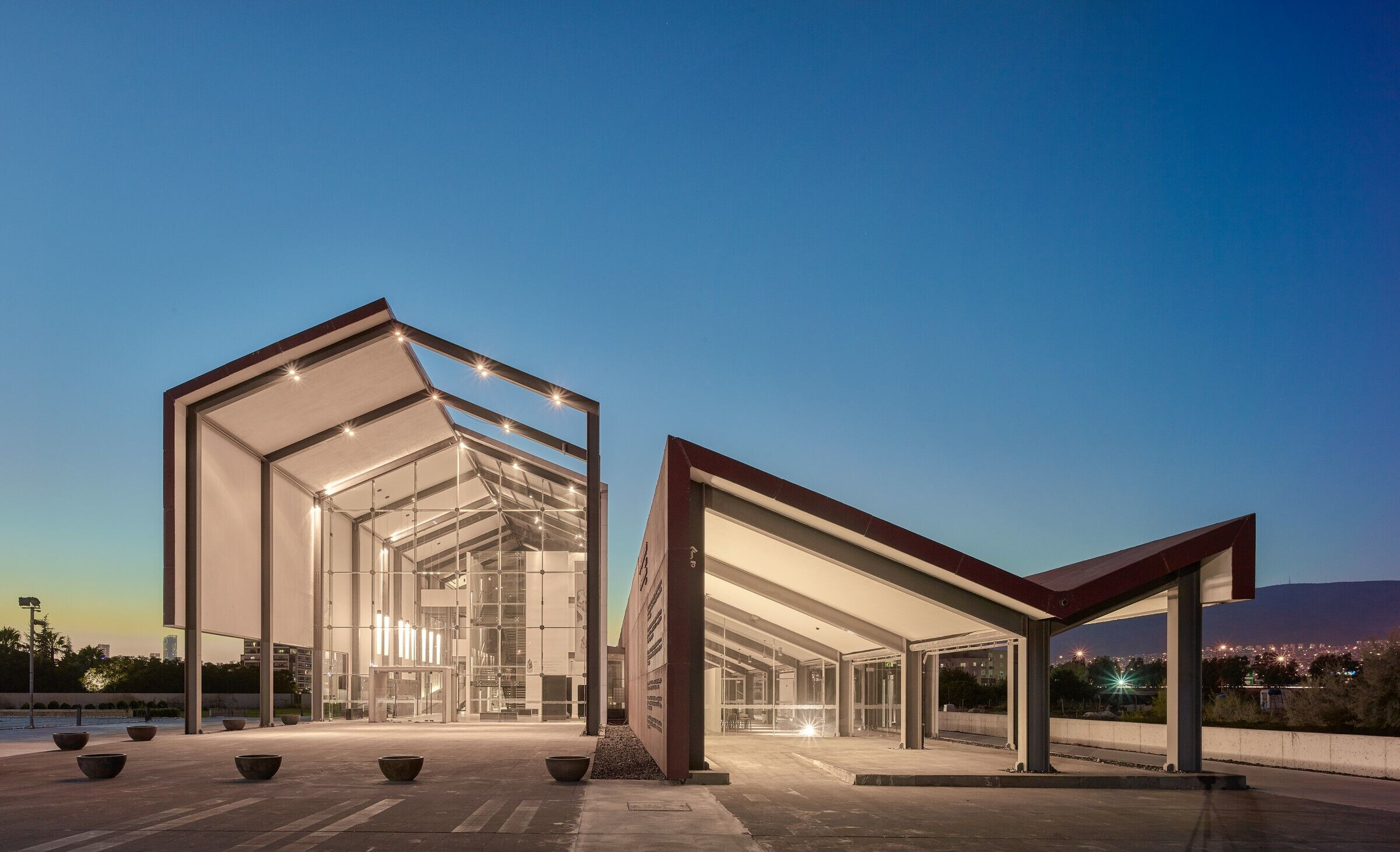
The tension generated by the location and program is sustained at all levels by means of the architectural context and choice of materials. The three main functions (Museum, Archaeological Laboratory and General Services) which are spatially linked to each other, generate the integrated building blocks that give the building its form. The functional program which is mainly composed of exhibition, education, and research has been enveloped between two surfaces of different characteristics: The southwestern opaque façade (Glass Fiber Reinforced Concrete Panels) which greets and welcomes the approaching visitor, and the northeastern translucent façade (Multi-Layered Polycarbonate Sheets) which gives the visitor hints about the archaeological excavation site that is outside and across the border.
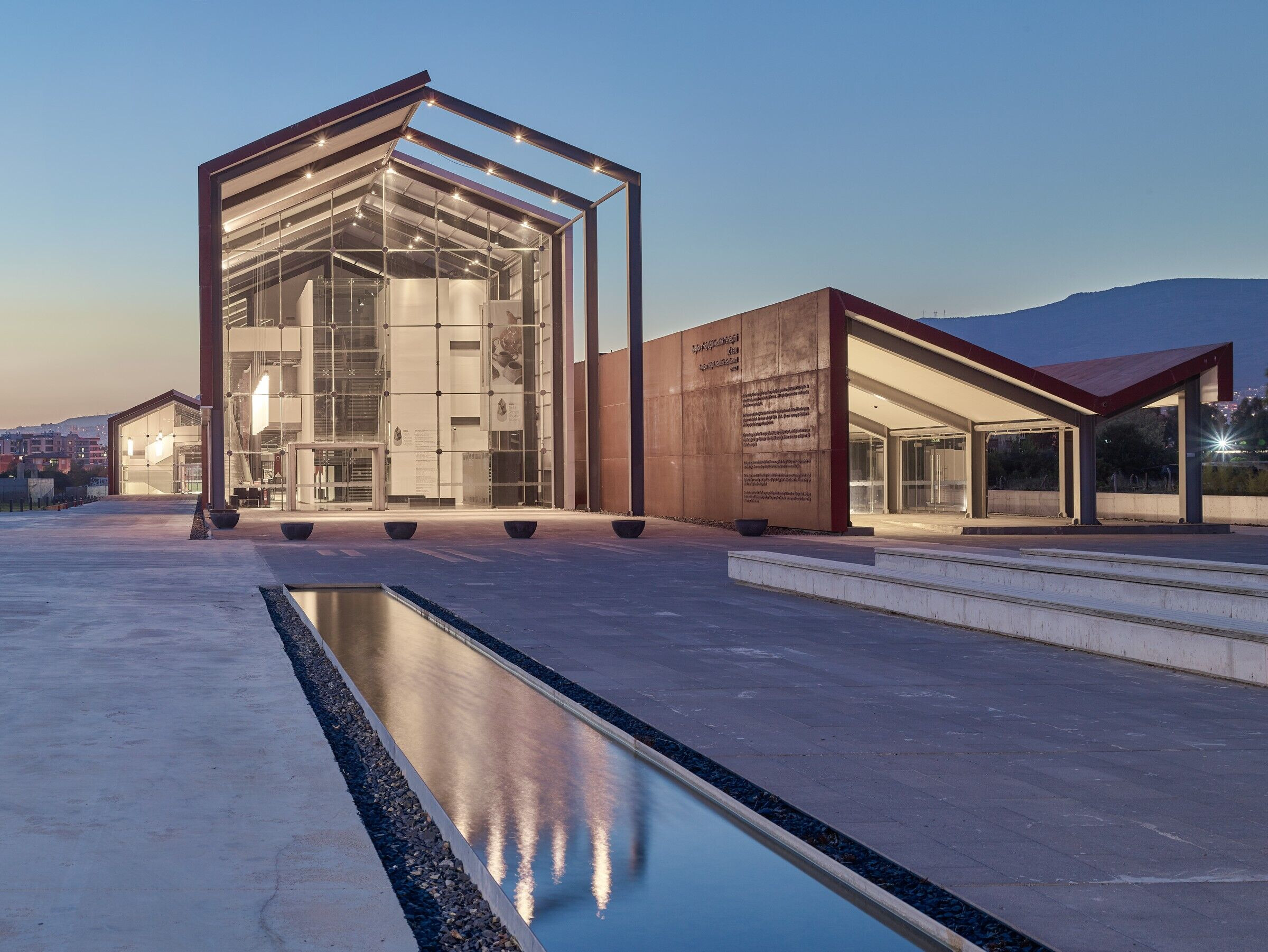
Project History:
In terms of its observable geometric form, Yeşilova Höyük is not in the ordinary form of a ‘höyük’ that can be found in vast numbers throughout Anatolian landscape. Since it is located on Bornova plain which is mainly a huge silt deposit, the tumulus seemed to be buried completely underground and therefore it was very hard to identify the settlement from outside. Höyük was discovered by chance in 2003 and archaeological excavations began in 2005 first under the patronage of first İzmir Archaeology Museum and then Republic of Turkey Ministry of Culture and Tourism and Ege University. The settlement dates back to early neolithic period (6.500 BC) and it is the oldest one discovered in the whole region.
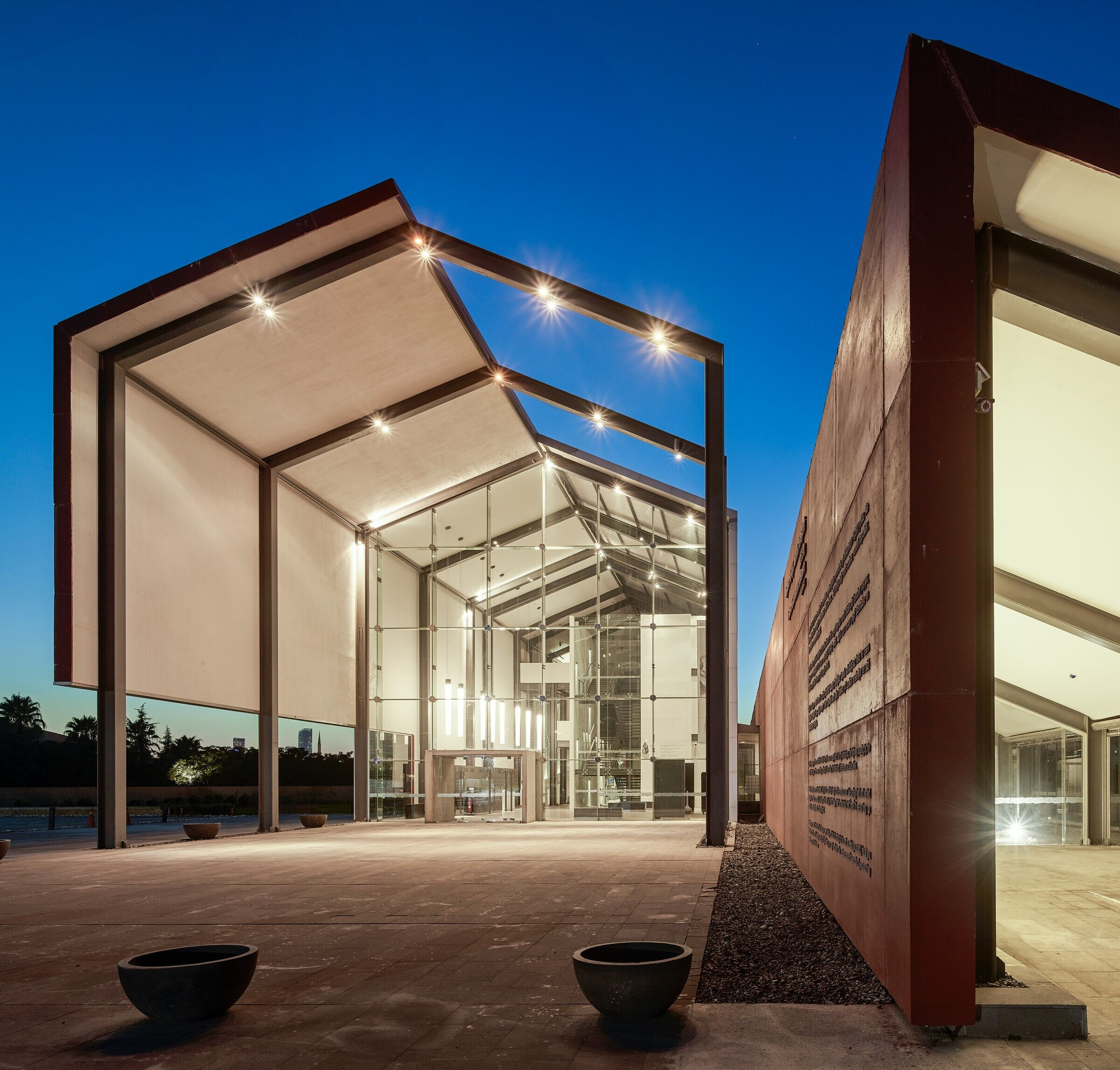
The idea to build a visitor center on the adjacent plot which will at the same time accommodate the excavation laboratories was undoubtedly a foresighted vision of the local government and it was one of the most influential cultural investments in the city. The design of the facility was acquired by a national architectural competition which was held in 2010. A partnership of young architects (Studio Evren Başbuğ Architects + SCRA Architects) have won the competition and they were commissioned by the municipality for the design and the shop drawings. The construction was completed and the building was opened for public use in early 2015.
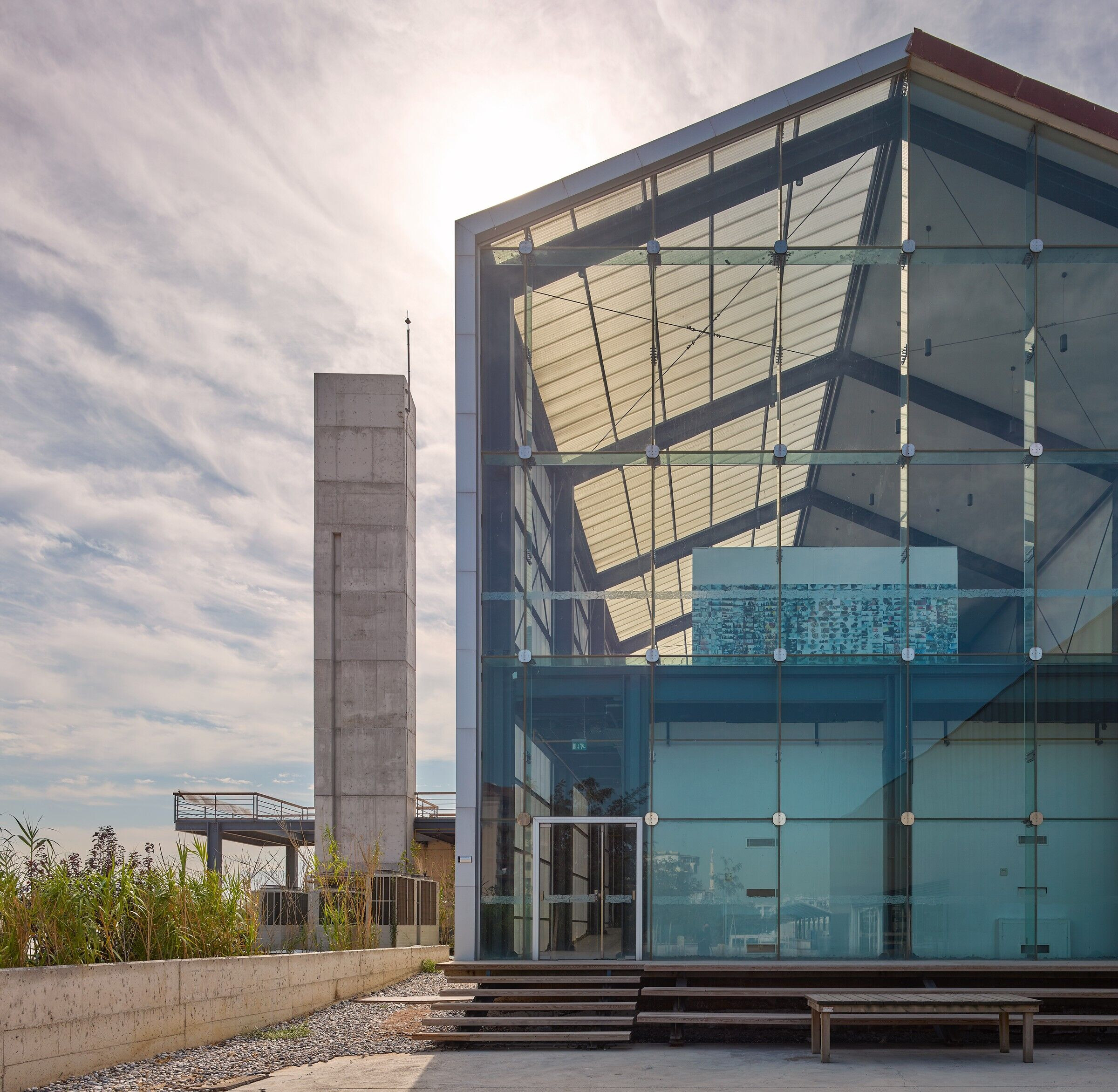
With the laboratories, work spaces and accommodation units in the facility, it is now possible to continue the archaeological excavation and related technical activities non-stop throughout the year. Today with its informative exhibition and renowned ‘time travel’ program, the facility offers a unique experience and an active learning environment for the visitors from all over the country (mainly for primary and secondary level students but not limited to them) and serves as an informal education center. In 2017, with the increasing interest by the local schools and educational institutions, the number of total annual visitors have passed 25.000 threshold. This number continues to increase day by day, getting closer to the number of annual visitors of some major archaeological sites such as Ephesus and Pergamon.
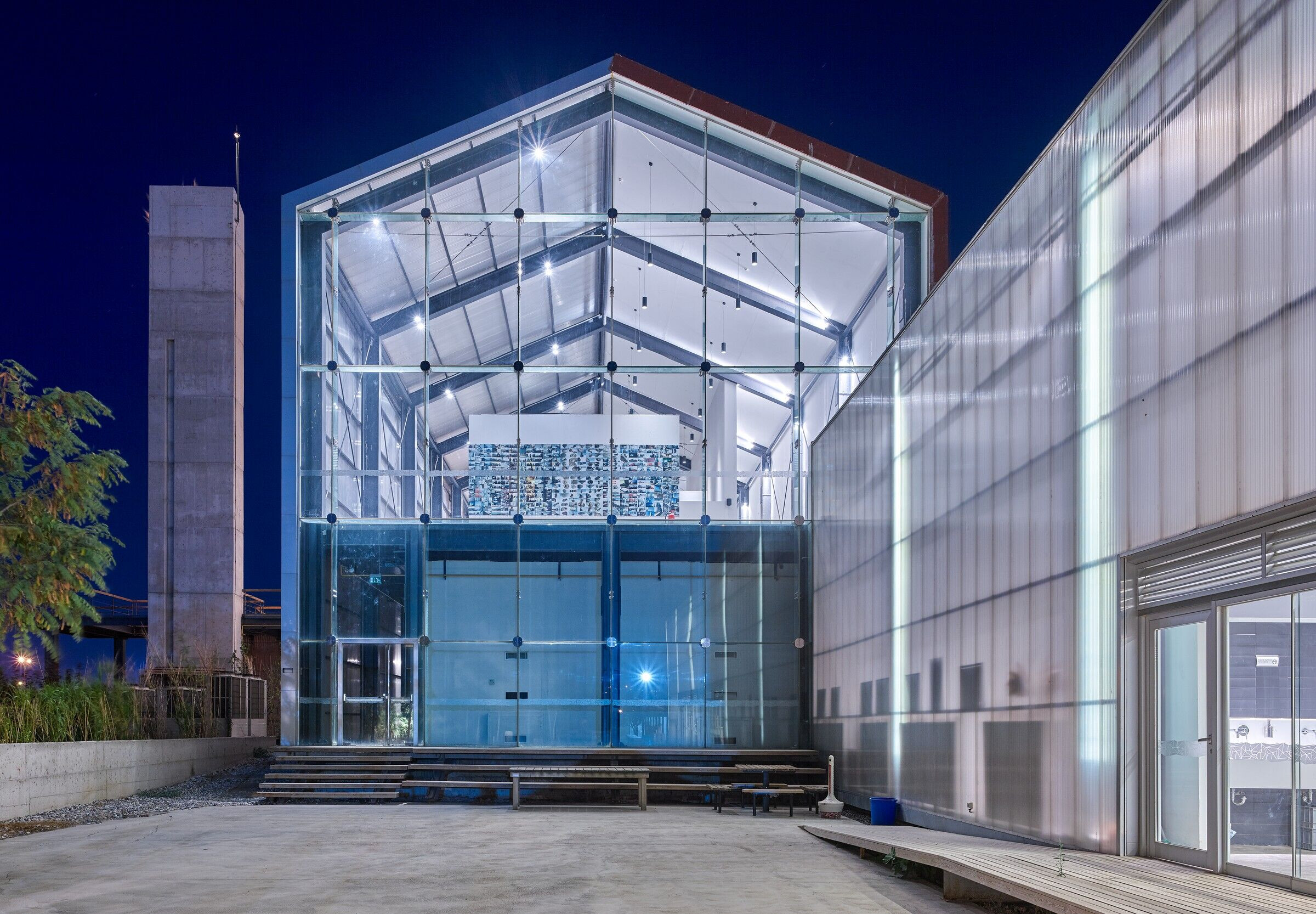
Project Information:
Settled in the adjacent plot along the northwest - southeast border of the Yesilova Höyük archaeological excavation site, the facility intends to create a spatial interface between 6.500 BCE and the present time with its form, alignment, and materials. It generates an unexpected cultural focus within the urban context through an intricate architectural program which is composed of artifact exhibition, active education, and scientific research.
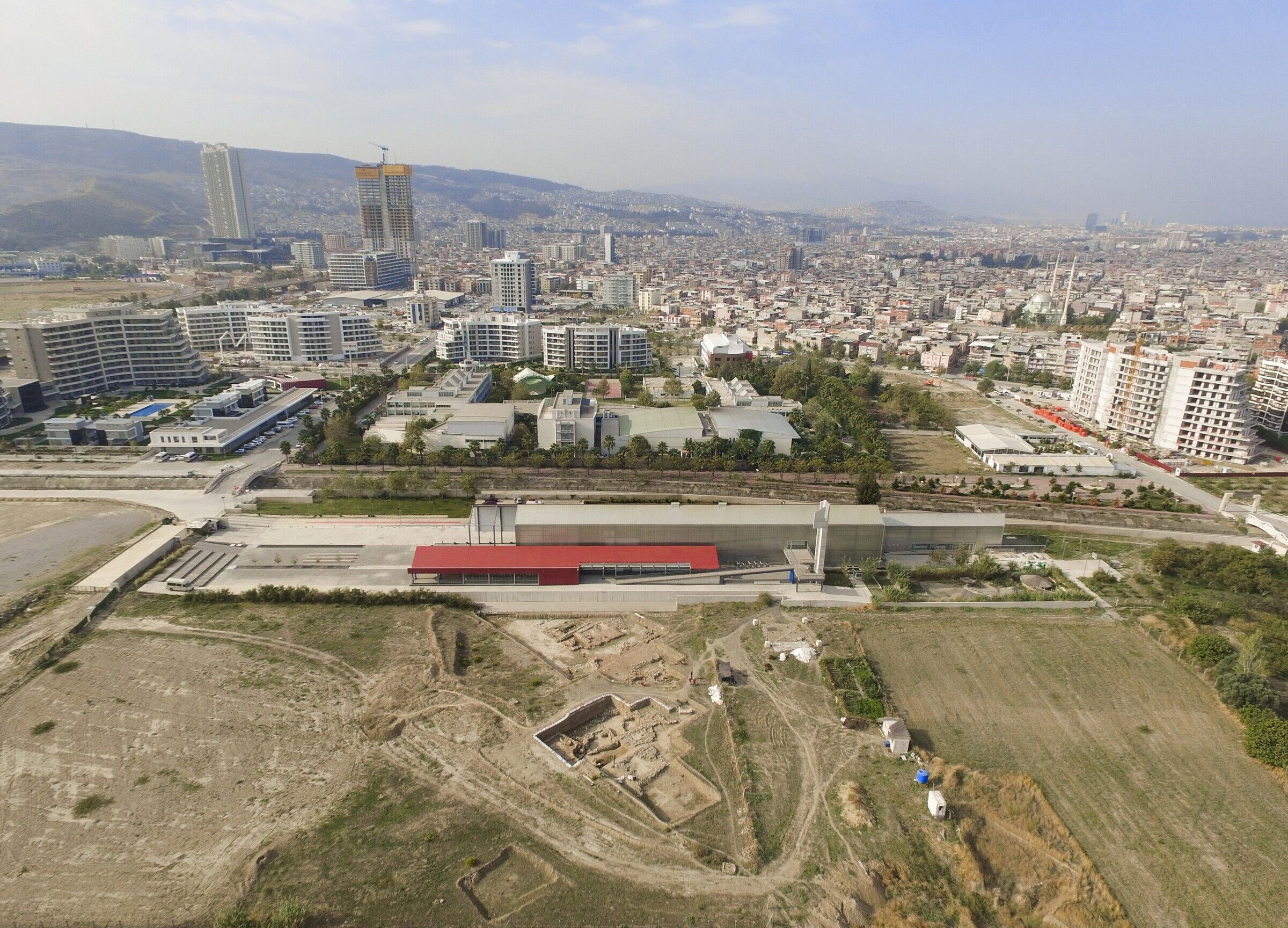
Three main functions (Museum, Archaeological Laboratory and General Services) which are spatially linked to each other, generate the integrated linear building blocks (155m long in total) with different sizes that give the building its form. The museum block in the middle is the widest (13m cross-section span) and highest (13.5m to the top ridge) of the three. The ground floor serves as a connector between different functions of the visitor center such as the reception hall, the archaeological laboratories, a cafeteria, an activity center, several media rooms, and a conference room for 100 people. The first floor is completely dedicated to the exhibitions and a (40m long) ramp connects this level with the reception area. There is also a mezzanine level in the exhibition space which was planned to be used as a library in the future.
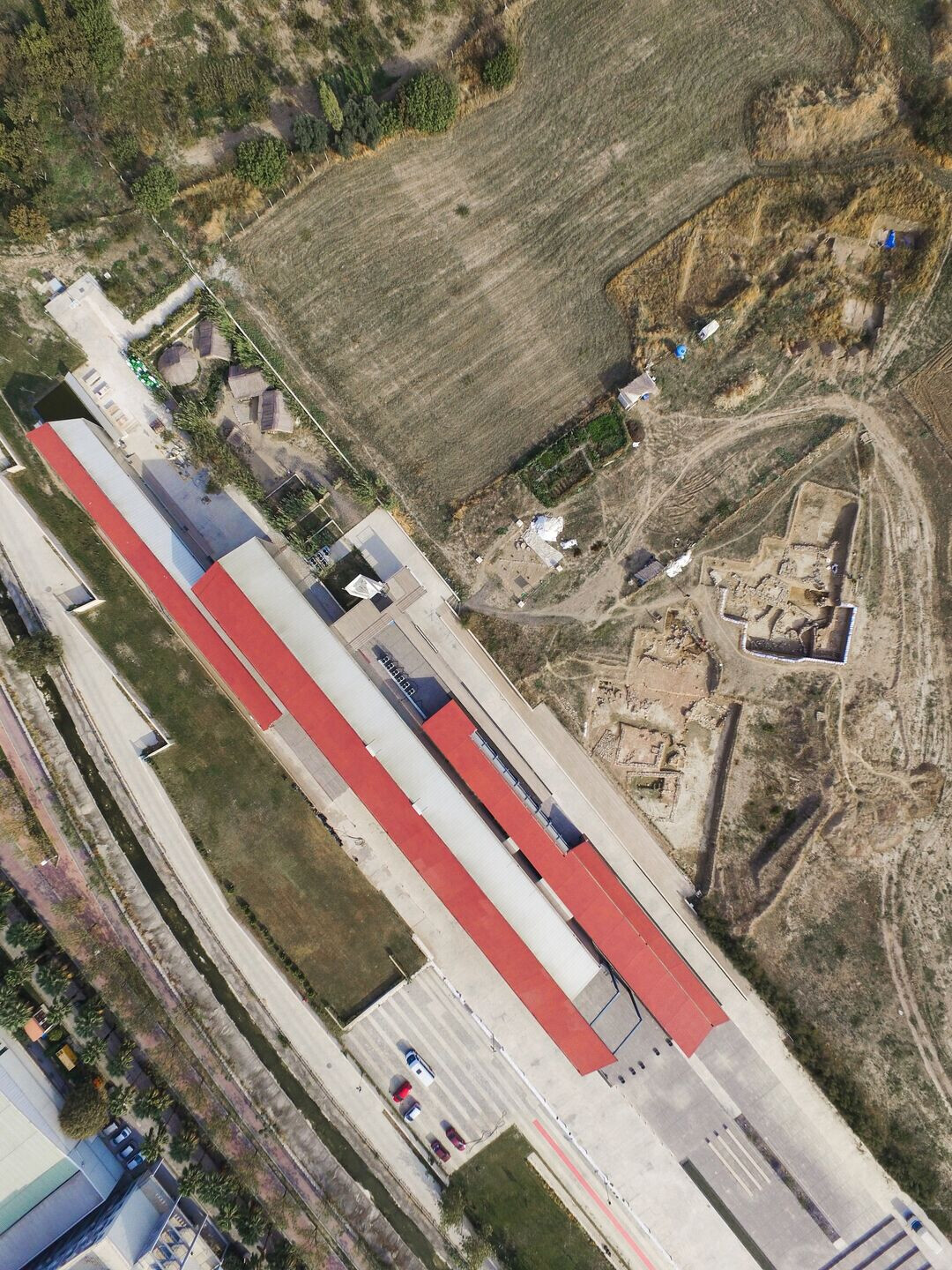
Archaeological laboratories with all the required services (lecture room, workshop, archive, kitchen and dormitories) are in the relatively smaller block in the north. This block is both visually and functionally connected to the adjacent open courtyard, which serves as an outdoor working space for the archeologists in summer time.
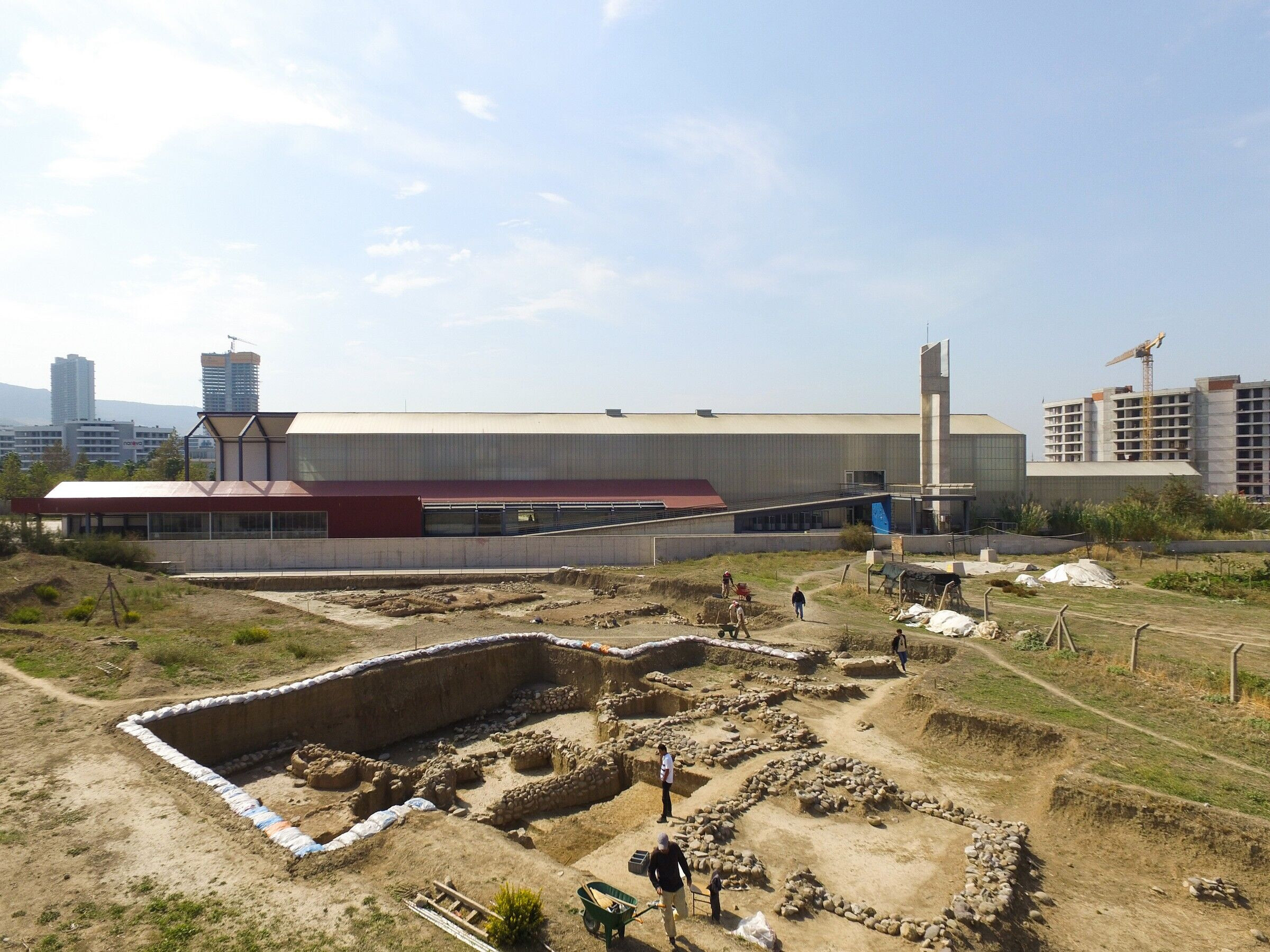
The viewing terrace was designed to be an extension of the main exhibition level stretching out towards the excavation site finalizing the tour of the visitor with the real encounter. The concrete torch is designed both as a vertical element balancing the highly linear scheme and as a visual indicator of the neolithic era with real fire lighted up on special occasions.
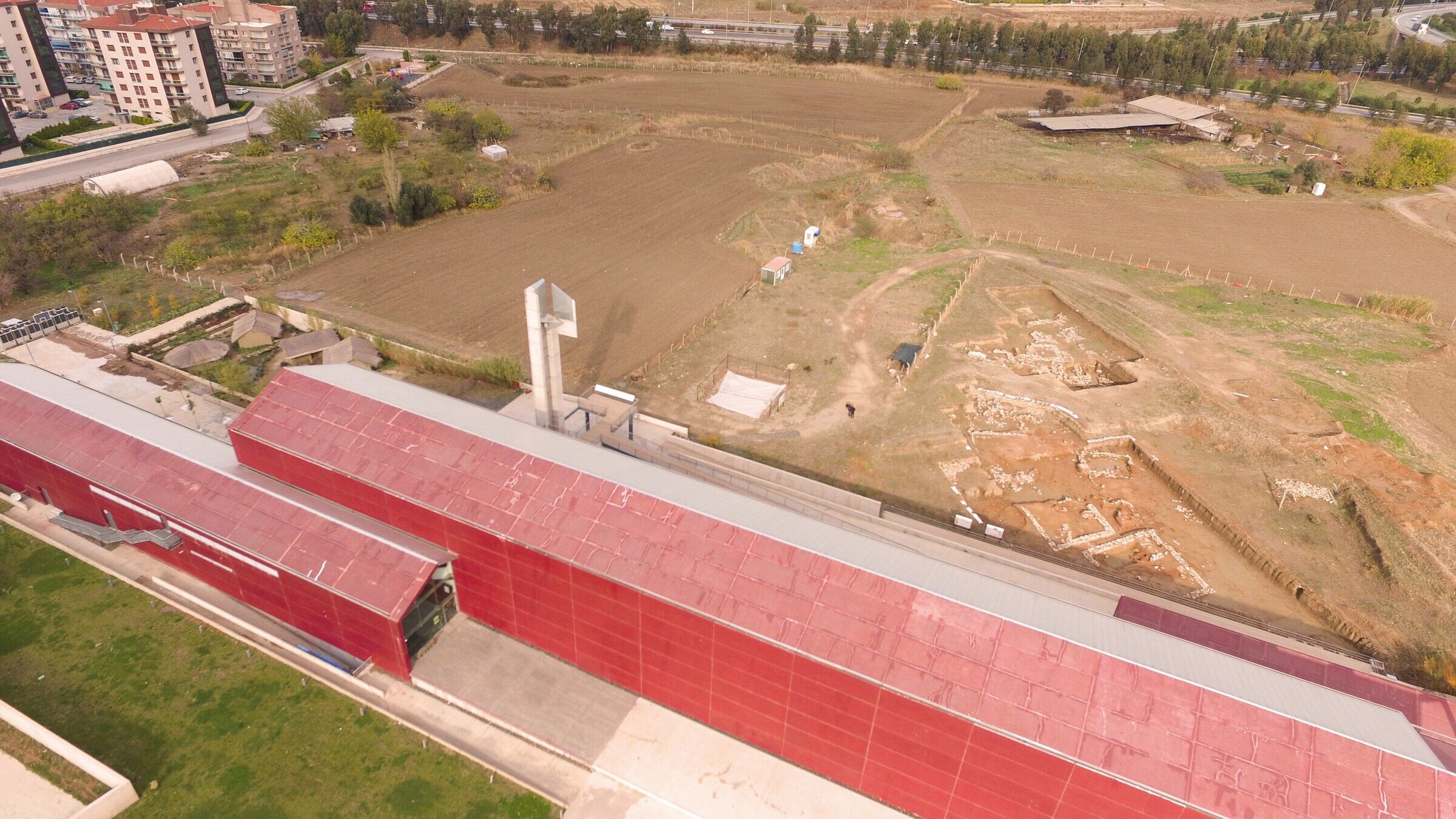
A simulation of a small village representing the real ancient settlement was planned outside next to the courtyard serving as a scene for the ‘time travel’ activity. Here children learn how to harvest, hunt, cook, and perform daily practices in a pre-scheduled 1 hour program.
The plot is 18.080 sqm in total (excavation site not included), and the building has a total construction area of 5.120 sqm.
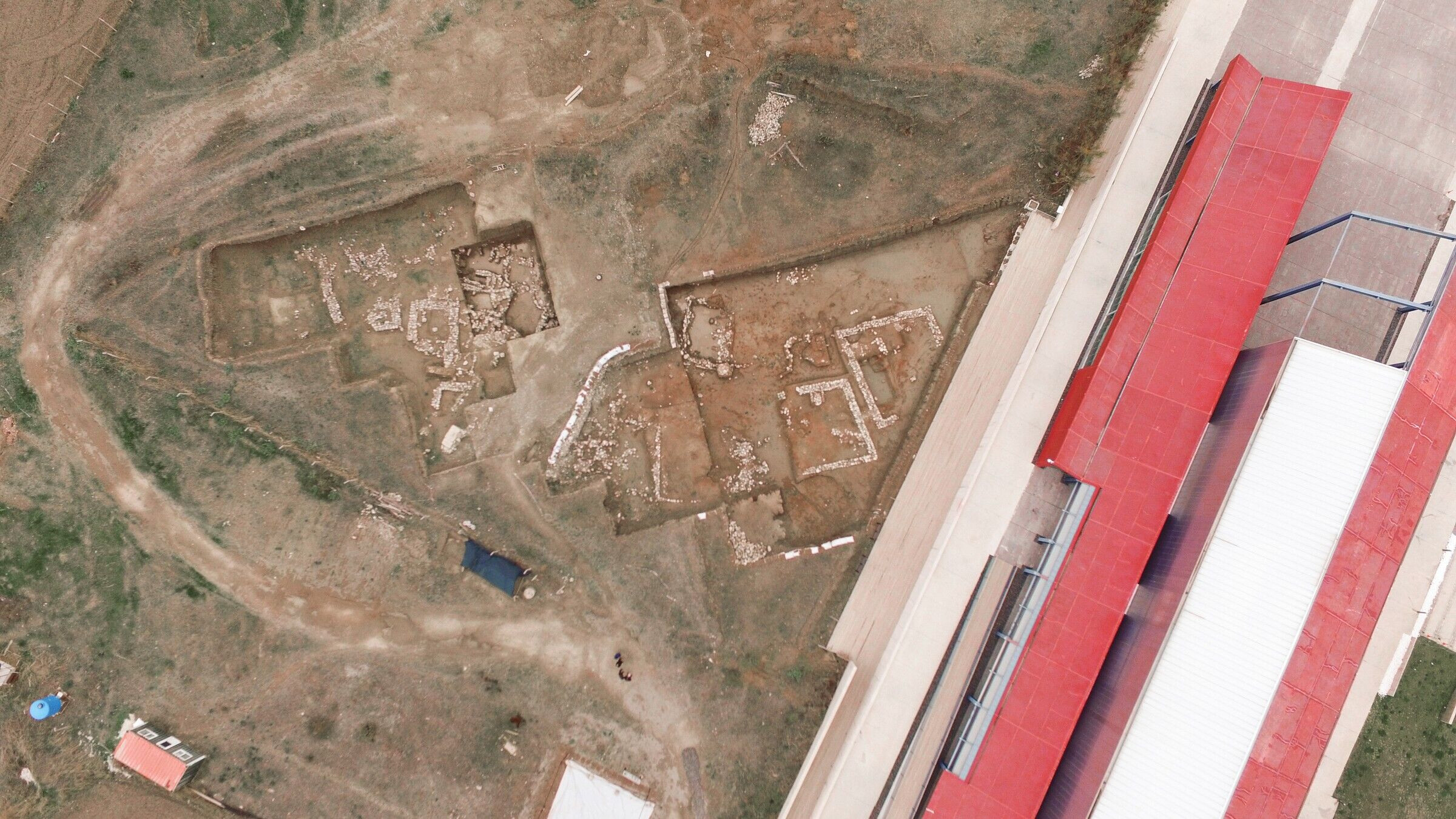
Materials, Construction and Technology:
The building complex is basically a steel structure formed by repeating identical H frames sitting on a concrete basement floor. These steel frames are enveloped on the outside with modern materials (glass fiber reinforced concrete panels and multi-layered polycarbonate sheets) but are exposed visually inside. This character is mainly a structural reference to the construction system of the neolithic era. The foundations discovered on the site reveal that the ancient houses were constructed over Masonry foundations by using wooden structural frames which are exposed visually inside but clad by mudbrick walls and clay surfaces outside.
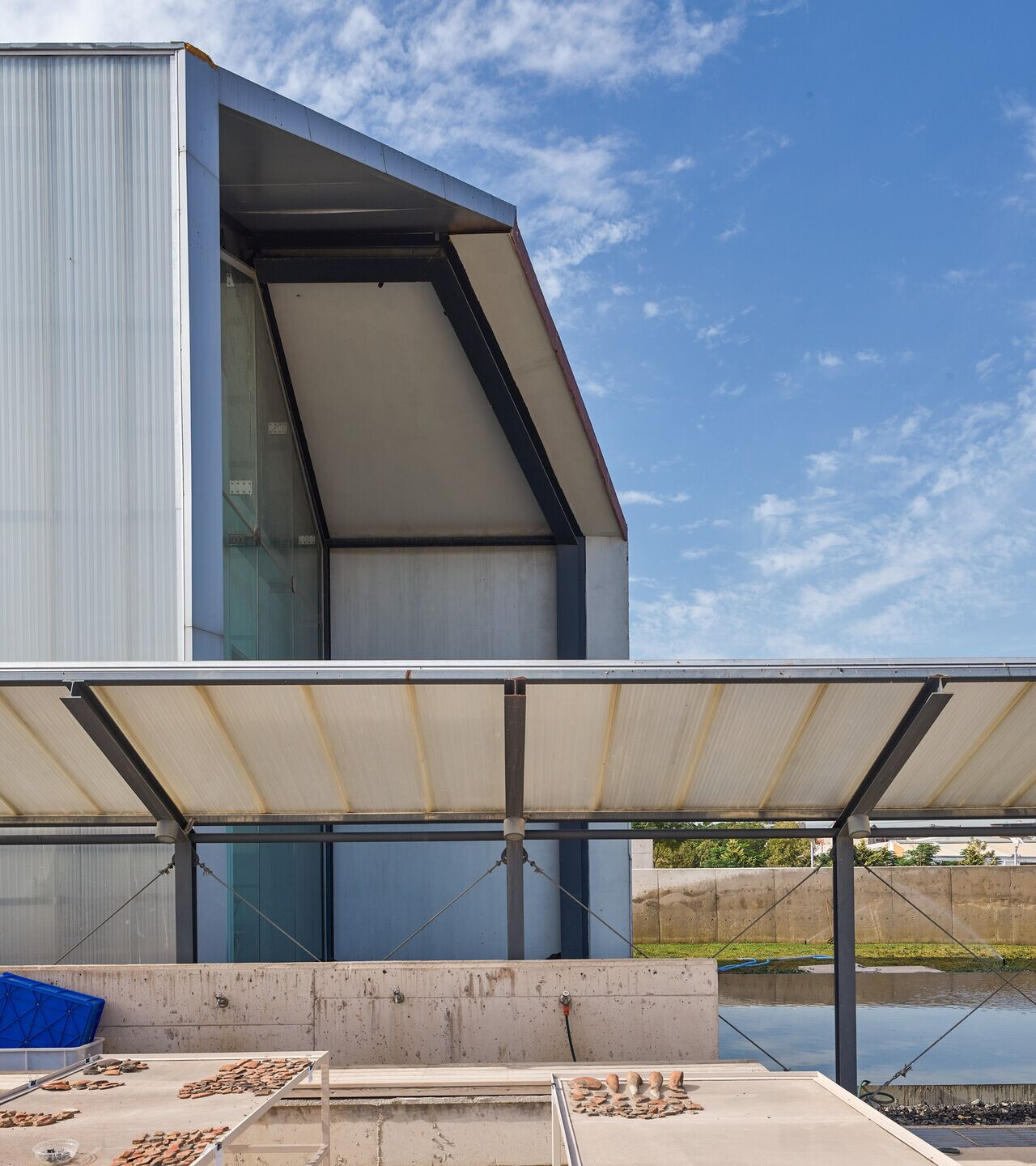
The tension generated by the unique location and architectural program of the facility is sustained at all levels by means of the architectural decisions and choice of materials. The architectural program in the form of integrated linear blocks have been enveloped between two surfaces of different characteristics on two sides: The southwestern opaque façade (Glass Fiber Reinforced Concrete Panels) which greets and welcomes the approaching visitor, and the northeastern translucent façade (Multi-Layered Polycarbonate Sheets) which gives the visitor hints about the archaeological excavation site on the adjacent plot outside. The red colour on the GRC panels is a clear reference to the most commonly used colour on the household items belonging to the neolithic era.
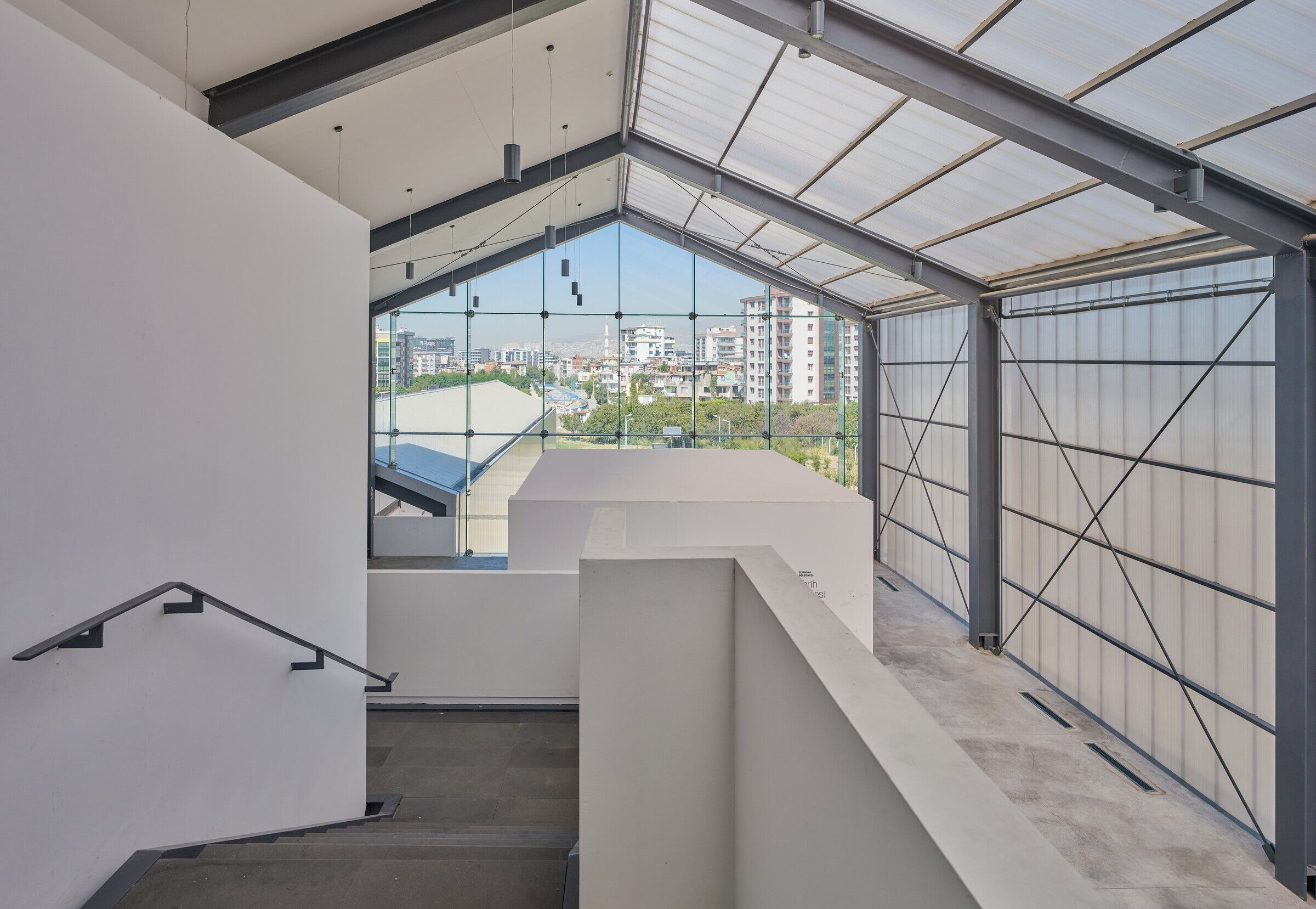
The decision of using materials that performing in contrast to one another, also creates an ideal situation in terms of the building’s climatic orientation and illumination performance: An impermeable, protective shield against the sun path, and a translucent membrane allowing diffused natural light in the exhibition space.
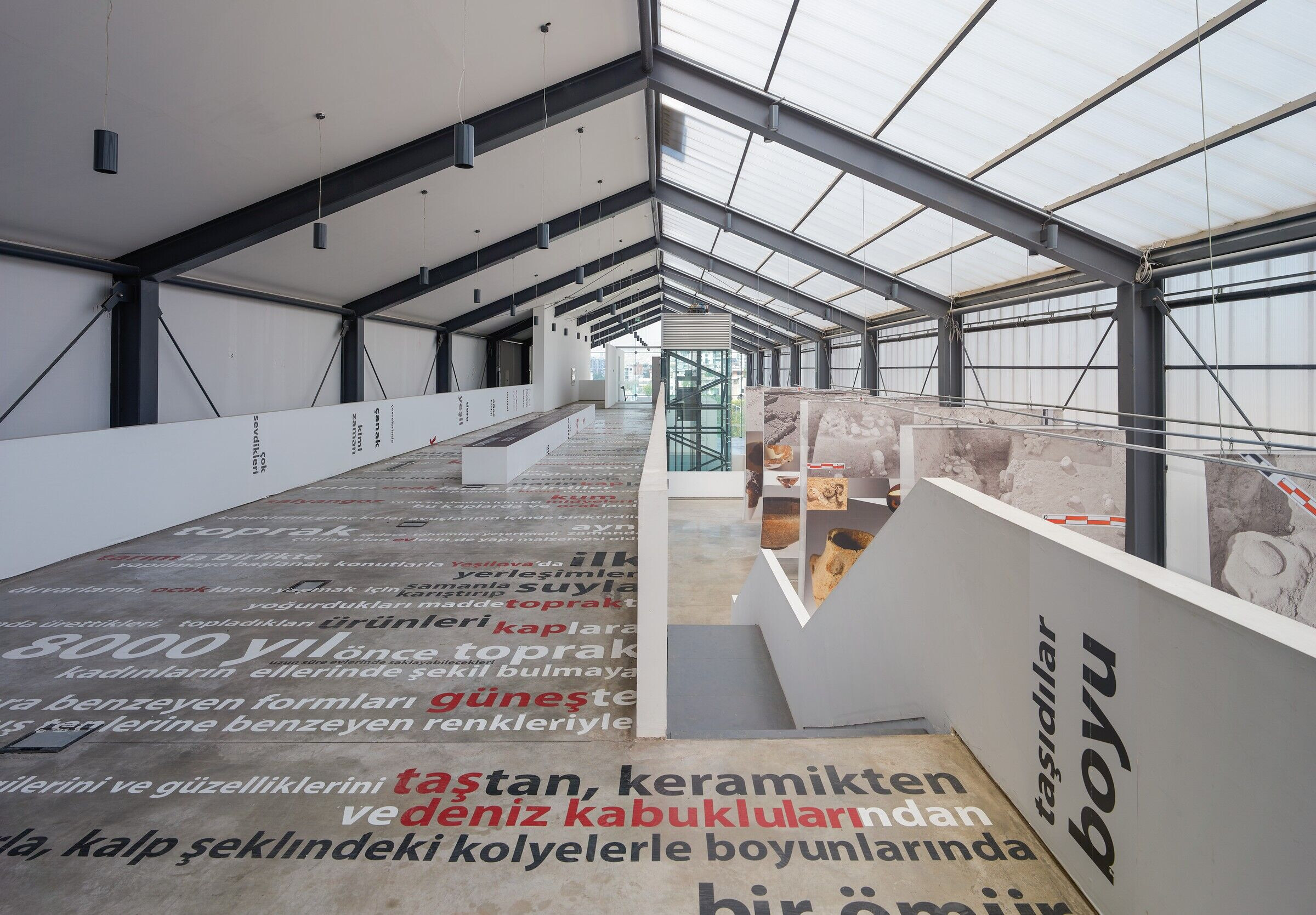
Project Significance and Impact:
On the surface of the wall defining the outdoor plaza, stands a greetings text designed (and written) by the architects as an integral and essential part of the architectural scheme. It is a fictional text, a call by an ordinary individual who lived in Yeşilova thousands of years ago, addressing directly to the present time visitors:
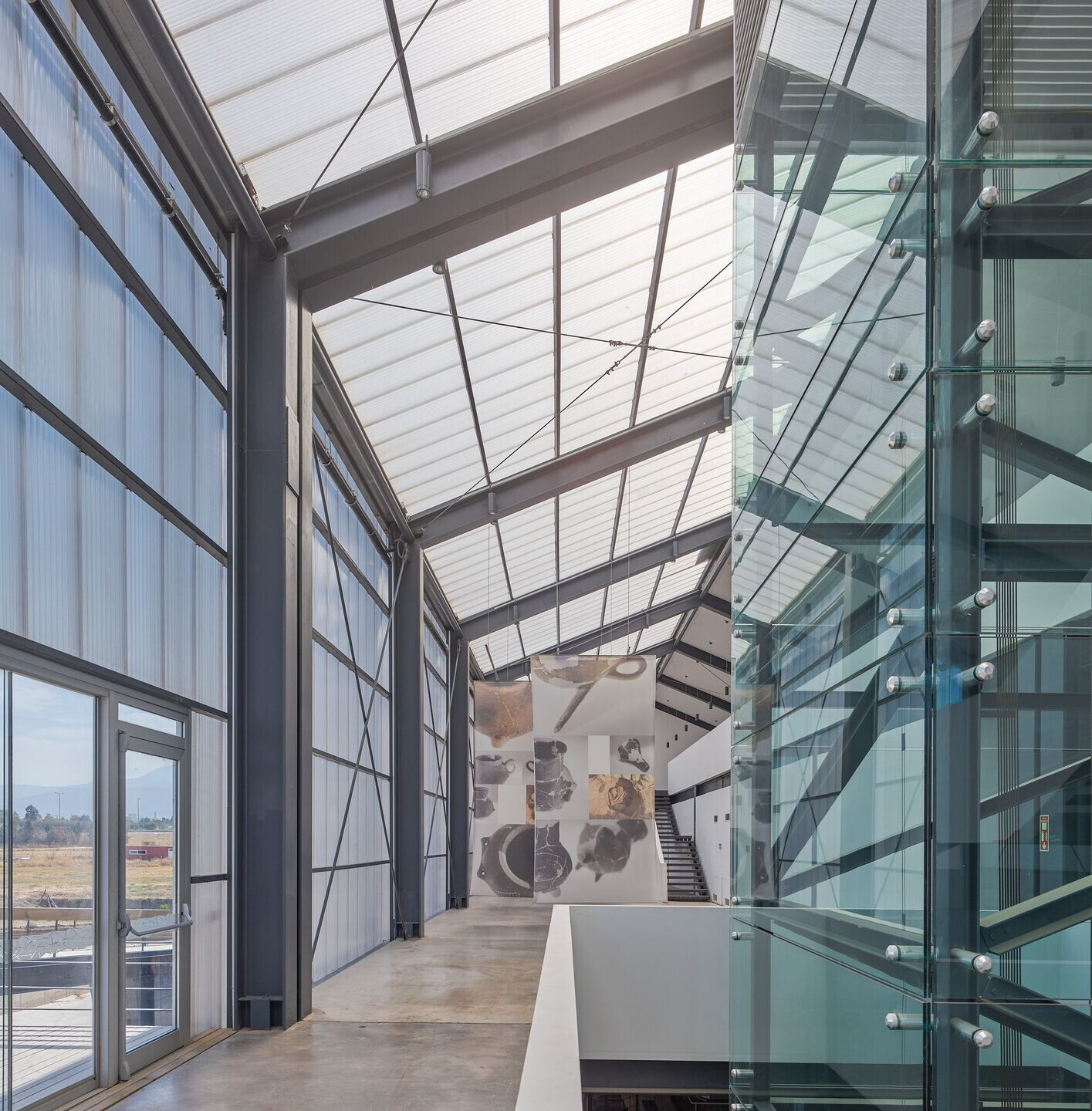
‘ Hi
8.500 years ago, when we first settled down on this land, none of the things you see around now had existed yet. The city behind you, the highway passing by, nor the wall standing in front of you; none of them... It was just nature and us.
You and us... We weren't that different. We, too, had a social life, though not as sophisticated as yours. We lived together just like you. Beyond this wall, lied our village, our huts, our "home"... It has been such a long time; all is underground now.
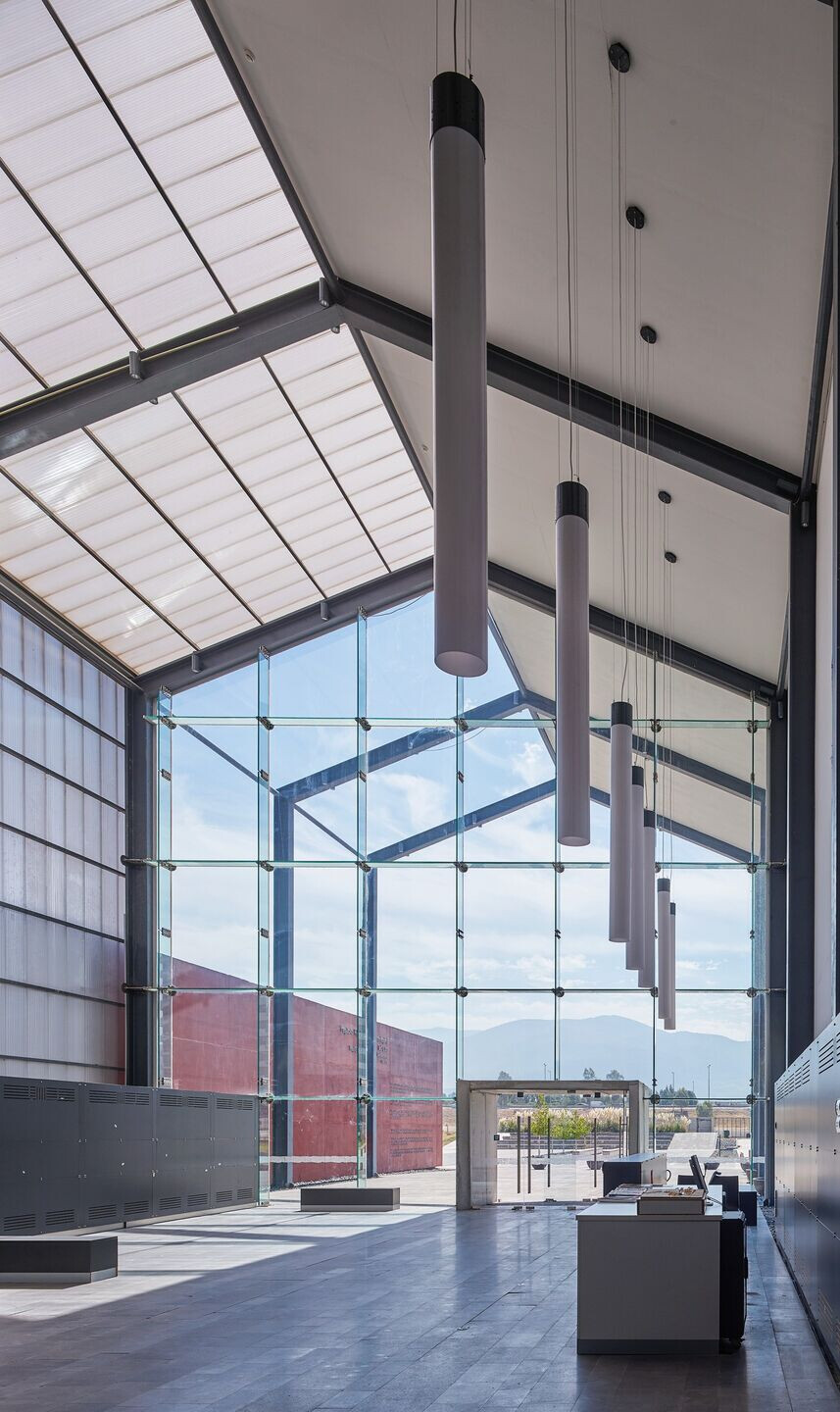
This is not a wall but a portal it seems: Binding what is yours and what was ours.
Now, before you proceed to the other side, please close your eyes just for a moment; and don't think of anything but the earth you're standing on, the air you breathe and the wind blowing around you. Everything that has happened for all this time, everything there is now, try to forget them all. Come in, with your simplest and your purest self. Because the only thing common in here and beyond, is "human".
That is you. That is us.
Welcome to our home. ’
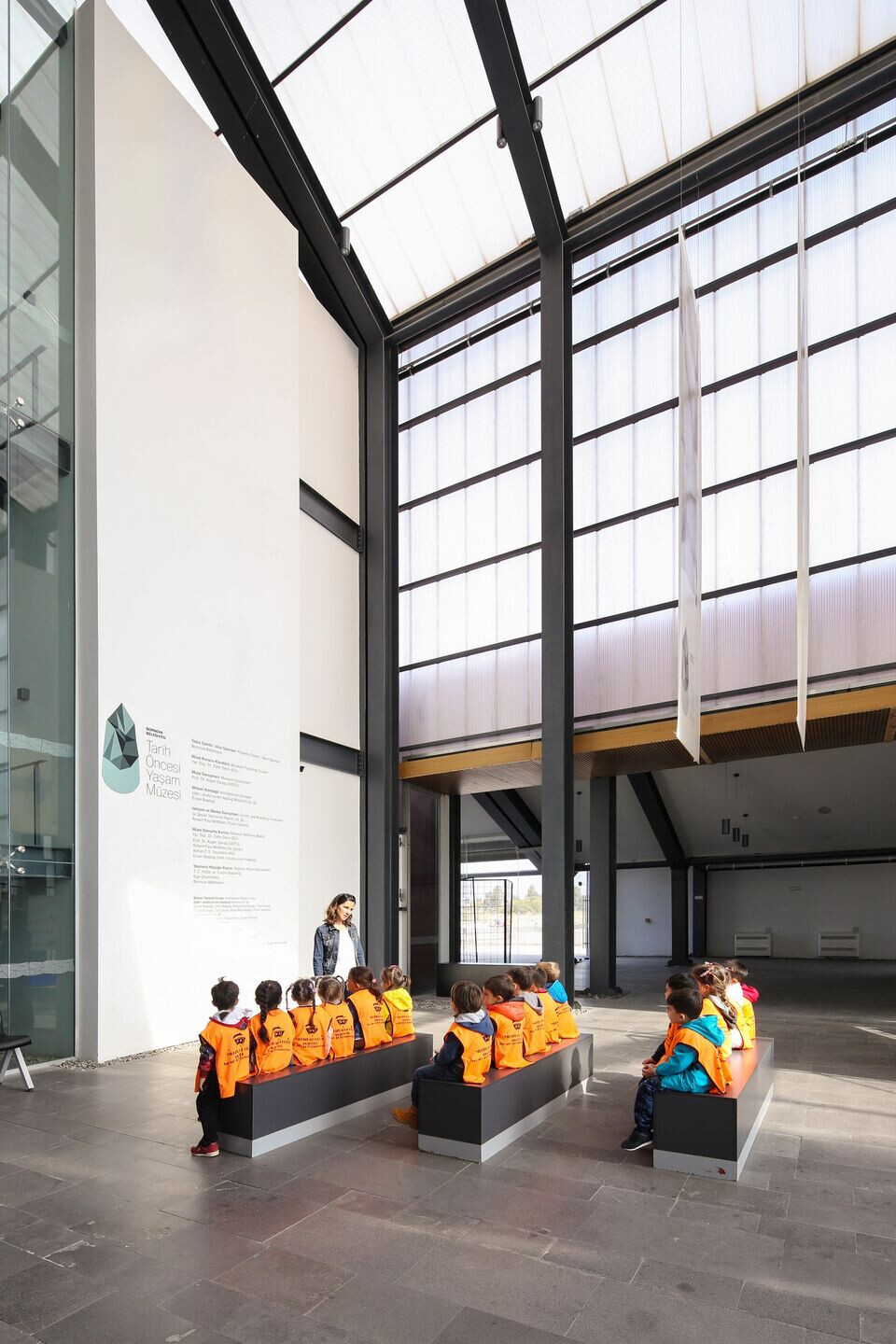
Upon arriving, visitor groups gather against this wall and read the message before entering the building. This orchestrated ritual triggered by the design, immediately forms a unique bond between the visitor and the site itself which extends far beyond the material existence of the building. This special bond with the original artifact (the höyük itself) is at the core of the design.

The building is just a tool which stands on a border line tearing apart 8.500 years in time and space. Therefore it is not meant to be in the leading role, but has been rather designed to act as the border itself; as a separator and a portal between the object (the höyük) and the subject (the visitor) at the same time. This binary character of the building is strengthened further by its linearity, position, alignment and materials.
The building greets the visitor, gently invites them in, informs them inside about the object (the höyük) and leads them out again bringing the subject and the object together finally.
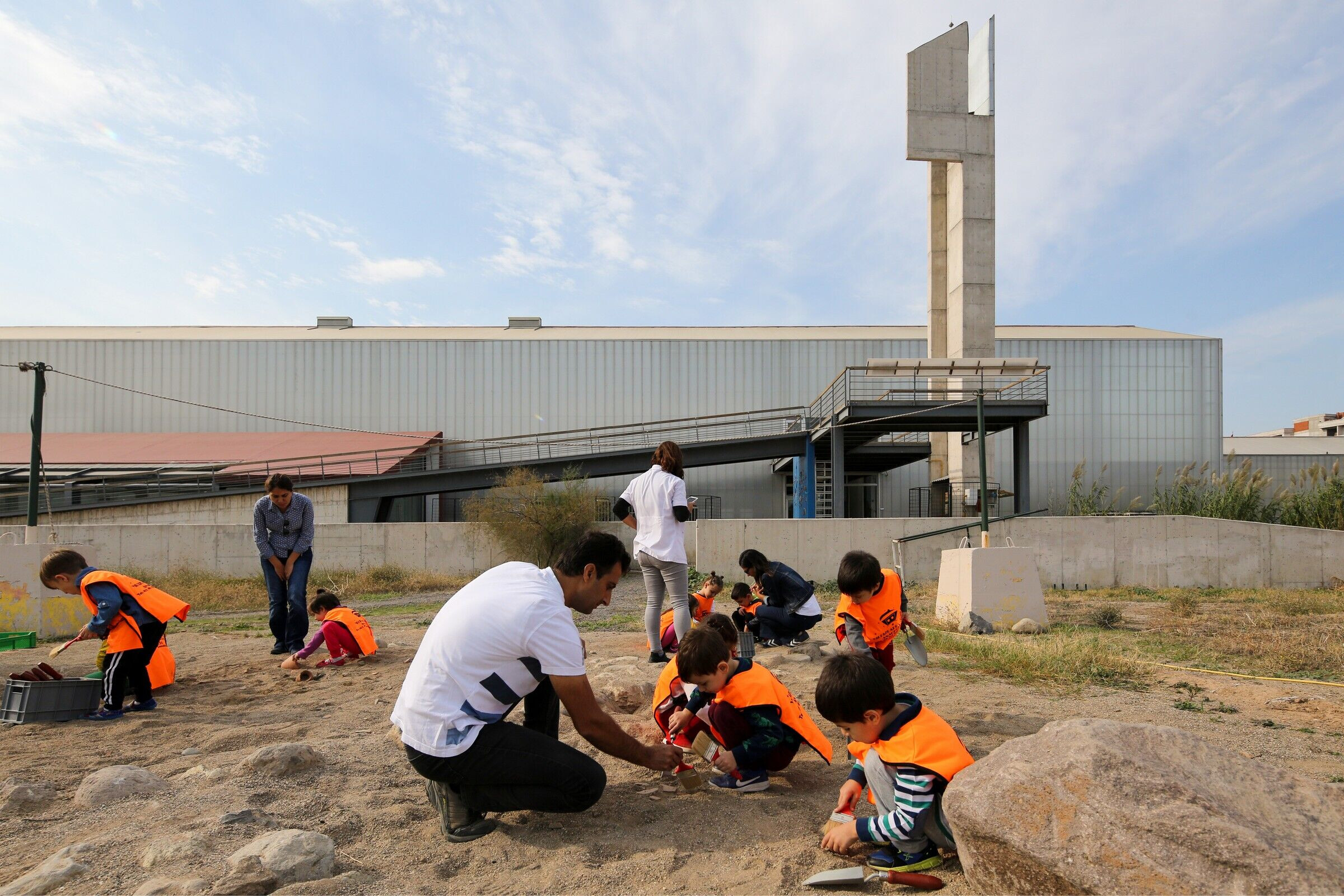
Considered as an inseparable pack with the building, the architectural program, the archaeological excavation site, the informal education program it offers; one of the major impacts of this project is the awareness that it created in a short time on an administrative level about the educational, urban, touristic and cultural potentials of such valuable sites. On a vast landscape of countless archaeological sites with similar potentials, this case sets a unique example for local governments both as a successful cultural investment vision realized on a limited public budget, and as a sustainable sophisticated collaboration model for ownership & management schemes.
